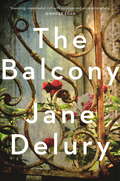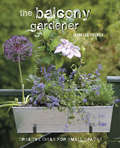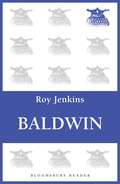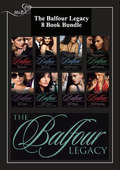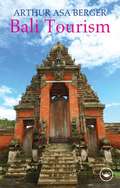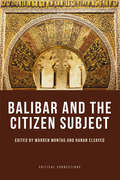- Table View
- List View
The BALB/c Mouse: Genetics and Immunology (Current Topics in Microbiology and Immunology #122)
by Michael PotterThe mouse was first used in immunological research by Paul Ehrlich in 1891 in an extraordinary series of experiments on the maternal transfer of antitoxic immunity. A short 22 years later in 1913 Halsey Bagg acquired a stock of albino mice from a commercial dealer and used them in a series of experiments on learning. Because he was interested in the genetics of intelligence, Halsey Bagg began breeding a pedigreed line of these mice that were subsequently named for him - Bagg Albino. Though Halsey Bagg is not credited with initiating the inbred strains of mice, his stock curiously has played an indisputably important role. Bagg Albinos were progenitors of the present day BALB/c family of sublines - the subject of this book. They were also used as one of the parents in the development of inbred strains A, CBA and C3H, three other very famous strains. Today the BALB/c mouse is among the five most widely used inbred strains in biomedical research and a particular favorite in immunology and infectious disease research. The hallmark of the BALB/c response to so many kinds of infections is susceptibility and sometimes an exaggerated susceptibility, but this paradoxically is not associated with immunodeficiency as BALB/c is an excellent responder to immuni zation. These characteristics have made the BALB/c mouse a model for identifying genes that determine susceptibility to infectious and neoplastic diseases. In 1985 the laboratory BALB/c mouse became 72 years old. The current filial generations are somewhere around 350 generations [MURPHY].
Balco Atlantico
by Jérôme FerrariIn a village square in Corsica lies the body of ardent nationalist, Stéphane Campana, shot down at close range. And over his body weeps Virginie, the young woman who has venerated Stéphane all her life - a veneration that has led her to abandon herself to him and his twisted desires completely.Meanwhile, brother and sister Khaled and Hayet, who once gazed out to sea from the shoreline path known as "Balco Atlantico" and dreamed of a better future, are now stranded in Corsica. As Ferrari traces the history of Stéphane and Virginie that leads to the shooting in the village square, we encounter the story of Khaled and Hayet and see through their story and the stories of many others in this one Corsican square how a relentless pursuit of happiness and fulfilment can bring us perilously close to despair and disillusionment.
The Balcony
by Jane DeluryWINNER OF THE SUE KAUFMAN PRIZE FOR FIRST FICTION FROM THE AMERICAN ACADEMY OF ARTS AND LETTERSWhat if our homes could tell the stories of others who lived there before us? To those who have ventured past it over the years, this small estate in a village outside Paris has always seemed calm and poised. But should you open the gates and enter inside, you will find rooms which have become the silent witnesses to a century of human drama: from the young American au pair developing a crush on her brilliant employer to the ex-courtesan shocking the servants, and the Jewish couple in hiding from the Gestapo to the housewife who begins an affair while renovating her downstairs. The stories of those who have lived within the estate have been many and varied. But as the years unfold, their lives inevitably come to haunt the same spaces and intertwine, creating a rich tapestry of the relationships, life-altering choices, and fleeting moments which have kept the house alive through the last hundred years. . .'Sweeping, suspenseful, rich with surprises and eerie atmosphere' Jennifer Egan
The Balcony Gardener: Creative ideas for small spaces
by Isabelle PalmerDiscover how to make the most of your gardening plot, however confined, with Isabelle's creative and inspiring projects, including creating a cocktail window box from which you can make your own delicious fruity drinks, recycling containers such as wine and fruit crates, and creating a country garden in the smallest urban space. You can also turn your balcony, roof terrace or patio into an attractive space to dine and entertain with stylish lighting and furnishing ideas. With The Balcony Gardener's uniquely different gardening ideas and practical advice, a lack of space won't hold you back; you will soon transform your mini-patch into a fabulous green oasis.Isabelle Palmer is the founder of The Balcony Gardener (www.thebalconygardener.com) an online company specialising in product ranges for small urban outdoor spaces. Isabelle studied at Chelsea College of Art and Design and then embarked on a degree in Economics before working in PR. She's always been a keen gardener before she started her successful business.
Balcony scene from Romeo and Juliet (Large Print)
by Rnib BookshareOn this page is a diagram showing the balcony scene from Shakespeare's play Romeo and Juliet. There is a locator dot shown, which will be at the top left of the page when the image is the correct way up. Juliet is in the top right corner of the page and Romeo is in the bottom left. A vertical line at the right of the image indicates the house wall from which the balcony juts out about a third of the way up. The floor of the balcony is supported on ornate stonework towards the bottom right of the page. Juliet stands on a balcony leaning out towards Romeo. She is facing to the left so that only one eye can be seen. Her hair is styled in a ponytail to the right with a headband that covers her ears. She is wearing a long gown that reaches her ankles and down from this her slippered feet can be found. The guardrail of the balcony is shown covering part of her dress and there is a decorated supporting column to her left. She is holding her arms out to Romeo who is standing down and to the left of her. Romeo stands facing to the right so that only one eye can be found. He has a large floppy hat with a feather to the left and down from this is his long hair. Down the page is his body wearing a short jerkin, nipped in at the waist. To the right of this are his arms, outstretched to Juliet on the balcony. Further down he is wearing knee-breeches and garters that hold up his hose (stockings). He wears light slippers on his feet at the bottom of the page. nbsp;
Balcony scene from Romeo and Juliet (UEB Contracted)
by Rnib BookshareOn this page is a diagram showing the balcony scene from Shakespeare's play Romeo and Juliet. There is a locator dot shown, which will be at the top left of the page when the image is the correct way up. Juliet is in the top right corner of the page and Romeo is in the bottom left. A vertical line at the right of the image indicates the house wall from which the balcony juts out about a third of the way up. The floor of the balcony is supported on ornate stonework towards the bottom right of the page. Juliet stands on a balcony leaning out towards Romeo. She is facing to the left so that only one eye can be seen. Her hair is styled in a ponytail to the right with a headband that covers her ears. She is wearing a long gown that reaches her ankles and down from this her slippered feet can be found. The guardrail of the balcony is shown covering part of her dress and there is a decorated supporting column to her left. She is holding her arms out to Romeo who is standing down and to the left of her. Romeo stands facing to the right so that only one eye can be found. He has a large floppy hat with a feather to the left and down from this is his long hair. Down the page is his body wearing a short jerkin, nipped in at the waist. To the right of this are his arms, outstretched to Juliet on the balcony. Further down he is wearing knee-breeches and garters that hold up his hose (stockings). He wears light slippers on his feet at the bottom of the page. nbsp;
Balcony scene from Romeo and Juliet (UEB Uncontracted)
by Rnib BookshareOn this page is a diagram showing the balcony scene from Shakespeare's play Romeo and Juliet. There is a locator dot shown, which will be at the top left of the page when the image is the correct way up. Juliet is in the top right corner of the page and Romeo is in the bottom left. A vertical line at the right of the image indicates the house wall from which the balcony juts out about a third of the way up. The floor of the balcony is supported on ornate stonework towards the bottom right of the page. Juliet stands on a balcony leaning out towards Romeo. She is facing to the left so that only one eye can be seen. Her hair is styled in a ponytail to the right with a headband that covers her ears. She is wearing a long gown that reaches her ankles and down from this her slippered feet can be found. The guardrail of the balcony is shown covering part of her dress and there is a decorated supporting column to her left. She is holding her arms out to Romeo who is standing down and to the left of her. Romeo stands facing to the right so that only one eye can be found. He has a large floppy hat with a feather to the left and down from this is his long hair. Down the page is his body wearing a short jerkin, nipped in at the waist. To the right of this are his arms, outstretched to Juliet on the balcony. Further down he is wearing knee-breeches and garters that hold up his hose (stockings). He wears light slippers on his feet at the bottom of the page. nbsp;
Bald: 35 Philosophical Short Cuts
by Simon CritchleyA new and expansive collection of essays from one of the world's best-known popular philosophers The moderator of the New York Times’ Stone column and the author of numerous books on everything from Greek tragedy to David Bowie, Simon Critchley has been a strong voice in popular philosophy for more than a decade. This volume brings together thirty†‘five essays, originally published in the Times, on a wide range of topics, from the dimensions of Plato’s academy and the mysteries of Eleusis to Philip K. Dick, Mormonism, money, and the joy and pain of Liverpool Football Club fans. In an engaging and jargon†‘free style, Critchley writes with honesty about the state of world as he offers philosophically informed and insightful considerations of happiness, violence, and faith. Stripped of inaccessible academic armatures, these short pieces bring philosophy out of the ivory tower and demonstrate an exciting new way to think in public.
Balderdash & Piffle: One Sandwich Short Of A Dog's Dinner
by Alex GamesDiscover the fascinating stories behind the words and phrases we use every day. English is now the worlds most popular second language, understood by over 700 million people across the globe. Its use is amazingly broad: not only is it the language of Chaucer and Shakespeare, but also of hip-hop, international business and the internet (over 80% of home pages are in English). So where exactly do English words come from? They come from everywhere. English is a vast, rambling conglomeration of words and phrases from a huge variety of times and places, and every word has its own intriguing history. Balderdash & Piffle is a guidebook an entertaining look at what falls out of the chaotic family tree of English words when you uproot it and give it a damn good shake. Shaking the tree is writer, humourist and word-sleuth Alex Games. If youve ever wondered who first used cuppa in print, what language gave us shampoo, when we started saying window, where minging comes from, what Shakespeare had to say about geeks and why berk is really, really rude, youll find it all (and much more) inside. Youll also have the chance to do your own word-sleuthing, through the BBC Wordhunt appeal. Who knows if you have written evidence of a bouncy castle from before 1986, you could even re-write history
Balderdash & Piffle: One Sandwich Short Of A Dog's Dinner
by Alex GamesBalderdash & Piffle: One Sandwich Short of a Dog's Dinner is a thrilling ride through the provocative, bewildering and often downright bizarre world of language and etymology. From the brash jargon of celebrity magazines to the delicacies and feints of the euphemism, author and word-sleuth Alex Games has uncovered the remarkable stories that lie behind some of our best-loved words and expressions. By grouping words into distinct themes - such as put downs and insults, the vocab of fashionistas and the lingo of dodgy dealings - Balderdash & Piffle looks at the English language in a fresh and revealing light. Who was the original Jack the Lad? What is the tragic story behind the expression Sweet F.A.? Balderdash & Piffle will show you where thugs come from, why 'barmy' once had more to do with your beer than your brain, and how a little bit of 'hanky-panky' could literally work magic. From the 'Cloud-cuckoo-land' of Aristophanes to the town of Balaclava, this is a funny but rigorously researched account of English words and their origins. Drawing together sources as diverse as William Shakespeare, David Cameron and the Burnham-on-Sea Gazette, Alex Games recalls the trends, innovations and scandals that have produced some of our most familiar but least explored words and phrases. Accompanying a brand new series of the hit BBC television programme Balderdash & Piffle - and containing all the results of the 'Wordhunt' from the first series -this entertaining book is a treasure trove for English-language lovers everywhere.
Baldrige Award Winning Quality: How to Interpret the Baldrige Criteria for Performance Excellence
by Mark Graham BrownThe Malcolm Baldrige National Quality Award is the highest level of national recognition for performance excellence that a U.S. organization can receive. Now in its 18th edition, Baldrige Award Winning Quality is still the most widely used and recognized book on the Malcolm Baldrige National Quality Award. It provides readers with a simple, yet com
Baldwin
by Roy JenkinsFirst published in 1984, this is the first biography of Stanley Baldwin for more than ten years, although there had been four in the preceding decade. This is strange, for Baldwin has recently begun to swim back into fashion. In part this is a function of growing nostalgia for his period of power, the 1920s and 1930s. Still more, however, it is " because Mrs Thatcher's brand of Conservative leadership has made him an object of contrasting interest in a way that Harold Macmillan's or Edward Heath's never did. When a new exponent of an alternative style temporarily achieves notice, it is now frequently suggested that he might be a new Baldwin. This reappraisal is therefore appropriately timed. It is written by a skilled political biographer, from a non-Conservative, although not personally unsympathetic, standpoint.Baldwin was born in 1867, the son of a rich Worcestershire ironmaster, and educated at Harrow and Trinity College, Cambridge. He then worked in the family business for twenty years. Although the most self-conscious countryman amongst British Prime Ministers of the past hundred years or more, he was not a country squire and never owned more than a few acres of land. He did not enter the House of Commons until he was forty, and was not even a junior minister until the threshold of fifty. Less than six years later, in 1923, he became Prime Minister and dominated British politics for the next fifteen years - the only man of this century to hold the highest office three times.
Baldwin I of Jerusalem, 1100-1118: First Crusader, Count Of Edessa (1097-1100) And King Of Jerusalem (1100-1118) (Rulers of the Latin East)
by Susan B. EdgingtonBaldwin of Boulogne was born the youngest of three sons and marked out for a clerical career, yet in turn he became a First Crusader, first Latin count of Edessa and the founder of the Latin kingdom of Jerusalem. Nevertheless, remarkably, he has never been the subject of a full-length biography. This study examines in detail the stages of Baldwin’s career, returning to the contemporary evidence to discover the qualities that enabled him not only to succeed his brother as ruler in 1100 but to maintain and expand the new kingdom of Jerusalem through the next eighteen years in the face of aggression from Muslim enemies and rivalry from fellow crusaders.
Baldwin I of Jerusalem, 1100-1118 (Rulers of the Latin East)
by Susan B. EdgingtonBaldwin of Boulogne was born the youngest of three sons and marked out for a clerical career, yet in turn he became a First Crusader, first Latin count of Edessa and the founder of the Latin kingdom of Jerusalem. Nevertheless, remarkably, he has never been the subject of a full-length biography. This study examines in detail the stages of Baldwin’s career, returning to the contemporary evidence to discover the qualities that enabled him not only to succeed his brother as ruler in 1100 but to maintain and expand the new kingdom of Jerusalem through the next eighteen years in the face of aggression from Muslim enemies and rivalry from fellow crusaders.
Baldwin of Bourcq: Count of Edessa and King of Jerusalem (1100-1131) (Rulers of the Latin East)
by Alan V. MurrayBaldwin of Bourcq left his home in France in 1096 to join the great crusade summoned by Pope Urban II for the liberation of the holy sites and Christian peoples of Syria and Palestine from the domination of the Muslim Turks. In 1100 he became ruler of the Franco-Armenian county of Edessa. In 1118 he succeeded to the kingdom of Jerusalem. In just over two decades this younger son of a minor French count had become one of only a dozen kings in Western Christendom. To defend the principalities of Outremer against their Turkish and Egyptian enemies he travelled thousands of miles and led his troops in over two dozen campaigns. He spent two extended periods in Turkish captivity, yet he outlived almost all of his fellow crusaders, and died leaving the succession to his kingdom secure. This is the first biography in any language of a remarkable man. Drawing on a wide range of narrative and documentary sources, it gives an account of Baldwin’s ancestry and life from his first recorded appearance up to his death in 1131. It explains the complex and shifting geopolitics of the principalities of Outremer and the Muslim territories around them, and explores Baldwin’s character as a ruler and leader in war, the significance of his wide-ranging kinship network, and the succession to the kingdom of Jerusalem. Baldwin of Bourcq will appeal to students, teachers and researchers in Medieval History, especially Crusade Studies and Military History.
Baldwin of Bourcq: Count of Edessa and King of Jerusalem (1100-1131) (Rulers of the Latin East)
by Alan V. MurrayBaldwin of Bourcq left his home in France in 1096 to join the great crusade summoned by Pope Urban II for the liberation of the holy sites and Christian peoples of Syria and Palestine from the domination of the Muslim Turks. In 1100 he became ruler of the Franco-Armenian county of Edessa. In 1118 he succeeded to the kingdom of Jerusalem. In just over two decades this younger son of a minor French count had become one of only a dozen kings in Western Christendom. To defend the principalities of Outremer against their Turkish and Egyptian enemies he travelled thousands of miles and led his troops in over two dozen campaigns. He spent two extended periods in Turkish captivity, yet he outlived almost all of his fellow crusaders, and died leaving the succession to his kingdom secure. This is the first biography in any language of a remarkable man. Drawing on a wide range of narrative and documentary sources, it gives an account of Baldwin’s ancestry and life from his first recorded appearance up to his death in 1131. It explains the complex and shifting geopolitics of the principalities of Outremer and the Muslim territories around them, and explores Baldwin’s character as a ruler and leader in war, the significance of his wide-ranging kinship network, and the succession to the kingdom of Jerusalem. Baldwin of Bourcq will appeal to students, teachers and researchers in Medieval History, especially Crusade Studies and Military History.
Balfour and Weizmann: The Zionist, the Zealot and the Emergence of Israel
by Geoffrey LewisOn November 2, 1917, Arthur Balfour, then Foreign Secretary, wrote to Lord Rothschild to say that the British Government viewed with favor the establishment in Palestine of a national home for the Jewish people. The consequences of this statement have reverberated throughout the world in a crescendo of bitterness and violence ever since. It interposed a European (mainly Russian) Jewish cultural idea in an Arab land and it led eventually to the Arab-Israeli conflict. Eleven years before his declaration, Balfour had met the passionate Zionist and émigré chemist Chaim Weizmann while electioneering in Manchester. At the centre of Geoffrey Lewis's compelling book is the story of this encounter and the developing relationship between these two men: the Zionist and the Zealot, so different from each other, yet drawn together by forces that neither quite understood, with consequences that were to have a profound effect on the modern world.
The Balfour Legacy: Mia's Scandal / Kat's Pride / Emily's Innocence / Sophie's Seduction / Zoe's Lesson / Annie's Secret / Bella's Disgrace / Olivia's Awakening (The Balfour Legacy)
by Carole Mortimer Michelle Reid Sharon Kendrick Kim Lawrence Margaret Way Sarah Morgan India Grey Kate HewittAbsolute scandal has rocked the core of the infamous Balfour family. The glittering, gorgeous daughters are in disgrace. . .
Balfour's Shadow: A Century of British Support for Zionism and Israel
by David CroninThis is the controversial history of the British government's involvement in the Zionist project, from the Balfour Declaration in 1917 to the present day. *BR**BR*Written by the British Foreign Secretary Arthur James Balfour, the Declaration stated 'His Majesty's government view with favour the establishment in Palestine of a national home for the Jewish people, and will use their best endeavours to facilitate the achievement of this object.' Its impact on history has been immense and still reverberates a century later, starting what has been referred to as a hundred years of war against the Palestinian people.*BR**BR*This history focuses on the devastating events which resulted from the Declaration, such as the Arab Revolt, the Nakba and establishment of the state, the 1956 and 1967 wars, the Cold War and the Oslo period. It also shines a light on controversial figures such as Tony Blair. In doing so, Balfour's Shadow provides a fascinating take on this much-contested, important history.
Balfour's Shadow: A Century of British Support for Zionism and Israel
by David CroninThis is the controversial history of the British government's involvement in the Zionist project, from the Balfour Declaration in 1917 to the present day. *BR**BR*Written by the British Foreign Secretary Arthur James Balfour, the Declaration stated 'His Majesty's government view with favour the establishment in Palestine of a national home for the Jewish people, and will use their best endeavours to facilitate the achievement of this object.' Its impact on history has been immense and still reverberates a century later, starting what has been referred to as a hundred years of war against the Palestinian people.*BR**BR*This history focuses on the devastating events which resulted from the Declaration, such as the Arab Revolt, the Nakba and establishment of the state, the 1956 and 1967 wars, the Cold War and the Oslo period. It also shines a light on controversial figures such as Tony Blair. In doing so, Balfour's Shadow provides a fascinating take on this much-contested, important history.
Bali Tourism
by Arthur Asa BergerThe island of Bali has long been characterized in the West as the last “paradise” on earth, but there is far more to this small Indonesian province. Bali Tourism presents an enlightening ethnographic study of some of the most important icons—for tourists and locals alike—in Balinese culture and society and explores the growth of this island as an “exotic” vacation destination. In addition, it offers a firsthand look at many aspects of daily life, a semiotic analysis of its dominant cultural symbols, and insights into tourists’ perceptions of Bali. A thirty page photo section offers a unique glimpse at this remarkable island. Through a distinctive use of cultural analysis and psychoanalytic modes of interpretation, Bali Tourism offers an in-depth study of Balinese tourism, society, and character. This handy, easy-to-read text is an essential overview of what the island has to offer tourists and looks at the exciting possibilities—and the potential pitfalls—of visiting this extraordinary land. The book paints a vivid portrait of this country’s hidden gems and popular tourist destinations, exploring the ways visitors see Bali—and how the Balinese see visitors—as well as the promise and problems Bali faces in developing its tourism industry. Bali Tourism is an ideal book to read before visiting Bali yourself—or recommending/planning a trip for others. The fresh insights it presents will help make any trip to the region more rewarding for the traveler. It is also a unique scholarly resource, complete with informative tables, references, and a bibliography, for academics and students at all levels of tourism studies.
Bali Tourism
by Arthur Asa BergerThe island of Bali has long been characterized in the West as the last “paradise” on earth, but there is far more to this small Indonesian province. Bali Tourism presents an enlightening ethnographic study of some of the most important icons—for tourists and locals alike—in Balinese culture and society and explores the growth of this island as an “exotic” vacation destination. In addition, it offers a firsthand look at many aspects of daily life, a semiotic analysis of its dominant cultural symbols, and insights into tourists’ perceptions of Bali. A thirty page photo section offers a unique glimpse at this remarkable island. Through a distinctive use of cultural analysis and psychoanalytic modes of interpretation, Bali Tourism offers an in-depth study of Balinese tourism, society, and character. This handy, easy-to-read text is an essential overview of what the island has to offer tourists and looks at the exciting possibilities—and the potential pitfalls—of visiting this extraordinary land. The book paints a vivid portrait of this country’s hidden gems and popular tourist destinations, exploring the ways visitors see Bali—and how the Balinese see visitors—as well as the promise and problems Bali faces in developing its tourism industry. Bali Tourism is an ideal book to read before visiting Bali yourself—or recommending/planning a trip for others. The fresh insights it presents will help make any trip to the region more rewarding for the traveler. It is also a unique scholarly resource, complete with informative tables, references, and a bibliography, for academics and students at all levels of tourism studies.
Balibar and the Citizen Subject (Critical Connections)
by Warren Montag Hanan ElsayedExplores the core of Balibar’s work since 1980This collection explores Balibar’s rethinking of the connections between subjection and subjectivity by tracing the genealogies of these concepts in their discursive history. The 12 essays provide an overview of Balibar’s work after his collaboration with Althusser. They explain and expand his framework; in particular, by restoring Arabic and Islamic thought to the conversation on the citizen subject. The collection includes two previously untranslated essays by Balibar himself on Carl Schmitt and Thomas Hobbes. Key FeaturesThe first English-language edited collection to focus on BalibarPresents and explains Balibar’s key contributions to political theory and the history of political philosophyIncludes two essays by Balibar himself on Carl Schmitt and Thomas Hobbes: 'Schmitt’s Hobbes, Hobbes’s Schmitt' and 'The Mortal God and his Faithful Subjects: Hobbes, Schmitt and the Antinomies of Secularism'Contributors include Étienne Balibar, Nancy Armstrong, Giorgos Fourtounis, Mohamed Moulfi
Balibar and the Citizen Subject (Critical Connections)
by Warren Montag Hanan ElsayedExplores the core of Balibar’s work since 1980This collection explores Balibar’s rethinking of the connections between subjection and subjectivity by tracing the genealogies of these concepts in their discursive history. The 12 essays provide an overview of Balibar’s work after his collaboration with Althusser. They explain and expand his framework; in particular, by restoring Arabic and Islamic thought to the conversation on the citizen subject. The collection includes two previously untranslated essays by Balibar himself on Carl Schmitt and Thomas Hobbes. Key FeaturesThe first English-language edited collection to focus on BalibarPresents and explains Balibar’s key contributions to political theory and the history of political philosophyIncludes two essays by Balibar himself on Carl Schmitt and Thomas Hobbes: 'Schmitt’s Hobbes, Hobbes’s Schmitt' and 'The Mortal God and his Faithful Subjects: Hobbes, Schmitt and the Antinomies of Secularism'Contributors include Étienne Balibar, Nancy Armstrong, Giorgos Fourtounis, Mohamed Moulfi
Balik-Tanaw: Memoir of a Literary and Cultural Critic through Filipino Eyes
by Soledad S. ReyesBalik-Tanaw: The Road Taken is the memoir of the distinguished Filipino critic, Soledad S. Reyes. This book is a record of Reyess journey of more than seven decades where personal narrative intertwines with people and events, with social and political movements with which the country sought to negotiate the treacherous shoals in the postwar years. The account carries a fair amount of biographical data (as lodged in the critics memory in the absence of diaries), from her childhood into her college years. But as the context becomes wider and more complex, the narrative takes on a more analytical frame as she tries to make sense of disparate experiences whirling about her in the tumult of the 1970s and beyond, and in the startling changes in the political landscape, local and global, that now grip the Filipino nation. This account, according to the author, is a story of an individual constructing a narrative that seeks to impose order upon chaos by retrieving aspects of the past and weaving a series of recalcitrant experiences into a coherent whole. Published in association with De La Salle University Publishing House


